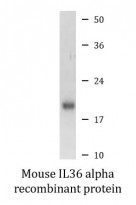ARG70182
Mouse IL36 alpha recombinant protein (Active) (His-tagged, C-ter)
Mouse IL36 alpha recombinant protein (Active) (His-tagged, C-ter) for SDS-PAGE
Overview
| Product Description | E. coli expressed, His-tagged (C-ter) Active Mouse IL36 alpha recombinant protein |
|---|---|
| Tested Application | SDS-PAGE |
| Target Name | IL36 alpha |
| Species | Mouse |
| A.A. Sequence | Met1 - His160 |
| Expression System | E. coli |
| Activity | Active |
| Activity Note | Determined by its ability to induce IL-6 secretion in 3T3 cells. The ED50 for this effect is < 15 ng/mL. The specific activity of recombinant mouse IL-36 alpha is > 1 x 10^5 IU/mg. |
| Alternate Names | FIL1; Interleukin-36 alpha; IL-1F6; IL-1 epsilon; Interleukin-1 family member 6; FIL1E; FIL1(EPSILON); FIL1 epsilon; IL1(EPSILON); IL1F6; Interleukin-1 epsilon |
Properties
| Form | Powder |
|---|---|
| Purification Note | Endotoxin level is less than 0.1 EU/µg of the protein, as determined by the LAL test. |
| Purity | > 98% (by SDS-PAGE) |
| Buffer | PBS (pH 7.4) |
| Reconstitution | It is recommended to reconstitute the lyophilized protein in sterile water to a concentration not less than 200 μg/mL and incubate the stock solution for at least 20 min at room temperature to make sure the protein is dissolved completely. |
| Storage Instruction | For long term, lyophilized protein should be stored at -20°C or -80°C. After reconstitution, aliquot and store at -20°C or -80°C for up to one month. Storage in frost free freezers is not recommended. Avoid repeated freeze/thaw cycles. Suggest spin the vial prior to opening. |
| Note | For laboratory research only, not for drug, diagnostic or other use. |
Bioinformation
| Gene Symbol | IL36A |
|---|---|
| Gene Full Name | interleukin 36, alpha |
| Function | Cytokine that binds to and signals through the IL1RL2/IL-36R receptor which in turn activates NF-kappa-B and MAPK signaling pathways in target cells linked to a pro-inflammatory response. Part of the IL-36 signaling system that is thought to be present in epithelial barriers and to take part in local inflammatory response; similar to the IL-1 system with which it shares the coreceptor IL1RAP. Seems to be involved in skin inflammatory response by acting on keratinocytes, dendritic cells and indirectly on T cells to drive tissue infiltration, cell maturation and cell proliferation. In cultured keratinocytes induces the expression of macrophage, T cell, and neutrophil chemokines, such as CCL3, CCL4, CCL5, CCL2, CCL17, CCL22, CL20, CCL5, CCL2, CCL17, CCL22, CXCL8, CCL20 and CXCL1, and the production of proinflammatory cytokines such as TNF-alpha, IL-8 and IL-6. In cultured monocytes upregulates expression of IL-1A, IL-1B and IL-6. In myeloid dendritic cells involved in cell maturation by upregulating surface expression of CD83, CD86 and HLA-DR. In monocyte-derived dendritic cells facilitates dendritic cell maturation and drives T cell proliferation. May play a role in proinflammatory effects in the lung. [UniProt] |
| Cellular Localization | Secreted. [UniProt] |
| PTM | N-terminal truncation leads to a dramatic enhancement of its activity (>1000-fold). [UniProt] |
Images (1) Click the Picture to Zoom In






